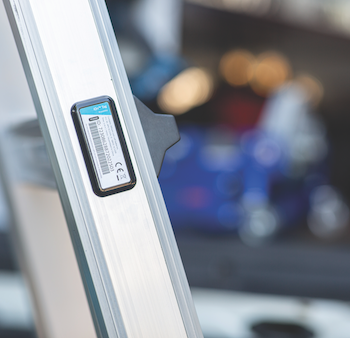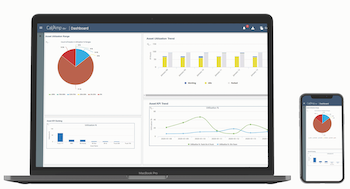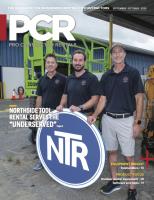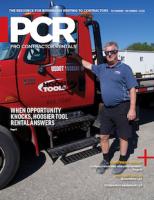Rental Solutions: Beyond GPS
How telematics information helps fleet management.
By Bill Westerman
Heavy construction equipment and vehicles are key assets, but they are also large investments. Construction companies and equipment rental centers work to manage the total cost of ownership (TCO) of each piece and strive for fleet cost efficiencies through careful utilization and maintenance.
 |
| The most used aspect of telematics is location monitoring via GPS, but there are other benefits that can be gathered with telematics. |
 |
| Back-office accounting and finance can use equipment utilization data for allocating job costs and for correctly bidding future jobs. |
Traditionally, companies collect data by inspecting and logging metrics. This process is time consuming and often inaccurate. Assets on a large job site are difficult to access and some data does not get collected. Plus, manual recordkeeping makes it difficult to integrate data into other back-office or service systems. Implementing asset telematics offers a way to improve the visibility of a mixed fleet, while seamlessly gathering and applying real-time and historical data for use across the company.
Data needs of fleet management
Project managers have an average of 120 regular responsibilities, according to the Construction Management Association. Tasks range from monitoring costs and time to meeting quality and safety parameters to following and verifying regulations. It’s no different for rental fleet managers.
They also want to know how much equipment is needed to complete each project stage so they can build a budget that not only covers the equipment purchase or rental cost, but also potential repair and replacement costs that affect the bottom line.
Job site construction managers handle the day-to-day activities from personnel to material delivery to managing the budget. Keeping track of an inventory of heavy equipment is yet another critical task, and it can be difficult to complete given the organized chaos of a typical project site.
In the past, crews typically made basic visual status checks of the equipment, noting the mileage, tread wear and fluid levels. Equipment was often overlooked, especially on large or irregularly configured job sites. Manual systems make it difficult to monitor if an asset is idling too much or if it was being overused, which raises the risk of an unexpected breakdown or falling out of warranty – both expensive propositions.
With better asset insight, managers can reallocate under-utilized equipment to other jobs. Companies gain full value from assets to better balance overhead costs and equipment depreciation.
Fleet and service managers are also interested in equipment utilization for maintenance purposes. Often, guesstimates or warranty guidelines determine service scheduling, which is a subjective process that has financial risk ranging from unexpected breakdowns to over-servicing machines.
The lack of data providing objective measurements could increase the total cost of maintenance (TCM), which is the yearly maintenance costs divided by the number of operating hours. According to John Kane of B2W Software, an average firm’s TCM ranges between 10 and 15 percent of total revenue, while companies with efficient processes have a TCM of 5 percent or less.
Back-office accounting and finance can use equipment utilization data for allocating job costs and for correctly bidding future jobs. Accurate project cost tracking can be the difference between profit and loss for equipment rental centers. However, this important information often inconsistently trickles in from the field.
Information beyond GPS
The most used aspect of telematics is location monitoring via GPS, but there are other benefits that can be gathered with telematics.
The AEM/AEMP Telematics Standard specifies that 19 specific data sets should be provided by certified solutions. This uniformity provides key formatted information to fleet managers. Most important to equipment fleet managers are:
- Machine identification
- Location
- Engine hours/miles
- Fuel usage
However, companies can employ telematics solutions that provide even more data. Device customizations and proprietary data points can offer another layer of rich information.
GPS monitoring makes machines and their data visible virtually. Fleet managers can locate a specific machine or a group of machines regardless of where they are, on site or off-site. This makes for faster, more accurate inventory at any point of the day or night.
Real-time tracking also reports any machine movement and a historical breadcrumb record. Managers can create virtual boundaries to monitor certain project areas or define various job sites. This makes it possible to:
• set up exception alerts and notifications. Visibility alerts can occur in real time so situations can be addressed as they happen, whether its equipment is being dropped off or in the event of unauthorized movement. It also can develop location reports to show regulatory compliance for crews working in sensitive or hazardous areas such as wetlands or weather-related disaster areas.
• gather data: The solution should provide complete logging of all data for later analysis that can help with accurate job costing and machine reallocation. The data can help uncover actual job or sub-project costs by tracking equipment needed and time spent within a defined area.
• improved maintenance. With telematics data, it’s possible to minimize the total cost of maintenance by building a system that integrates equipment data with information such as machine history and manufacturer recalls, warranties and parts inventory. Some firms even include repair and maintenance manuals in their telematics system interface.
• better repair or replace decisions by comparing current utilization vs. lifecycle costs. Engine or mileage data coupled with depreciation information helps managers determine if it is worth the upkeep to continue using a machine vs. having enough of a resale value to sell and replace.
Leverage expense data
Utilization and idling reports can help identify under- and overused equipment. Overworked equipment affects the total cost of ownership and operating expenses because it shortens asset life and runs up service costs. If overutilization happens, managers can plan purchases to balance the load.
It can also identify under-utilization. Mercury Associates, a fleet management consulting firm that provides unbiased technical assistance and advice to fleet organizations reports, “For a fleet of 1,000 units, eliminating 100 units can not only save more than $300,000 per year, but can also yield a substantial cash infusion from the sale of eliminated units.”
Telematics can help improve operator/driver productivity while improving safety. Managers can analyze common project utilization, then develop a standard and work with crews to meet them. Setting up alerts help reduce the risk and potential cost of accidents. Post-accident, telematics data can help managers assess what happened. Showing good safety processes could decrease insurance premiums.
 |
Editor's note:
Bill Westerman, vice president, Product Management at CalAmp, a telematics pioneer leading transformation in a global connected economy. Its software applications, scalable cloud services and intelligent devices collect and assess business-critical data from mobile assets, cargo, companies, cities and people.
This article originally appeared in the November-December 2020 issue of Pro Contractor Rentals magazine. © 2020 Urbain Communications LLC. All rights reserved.










